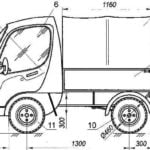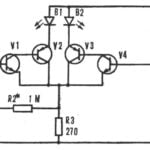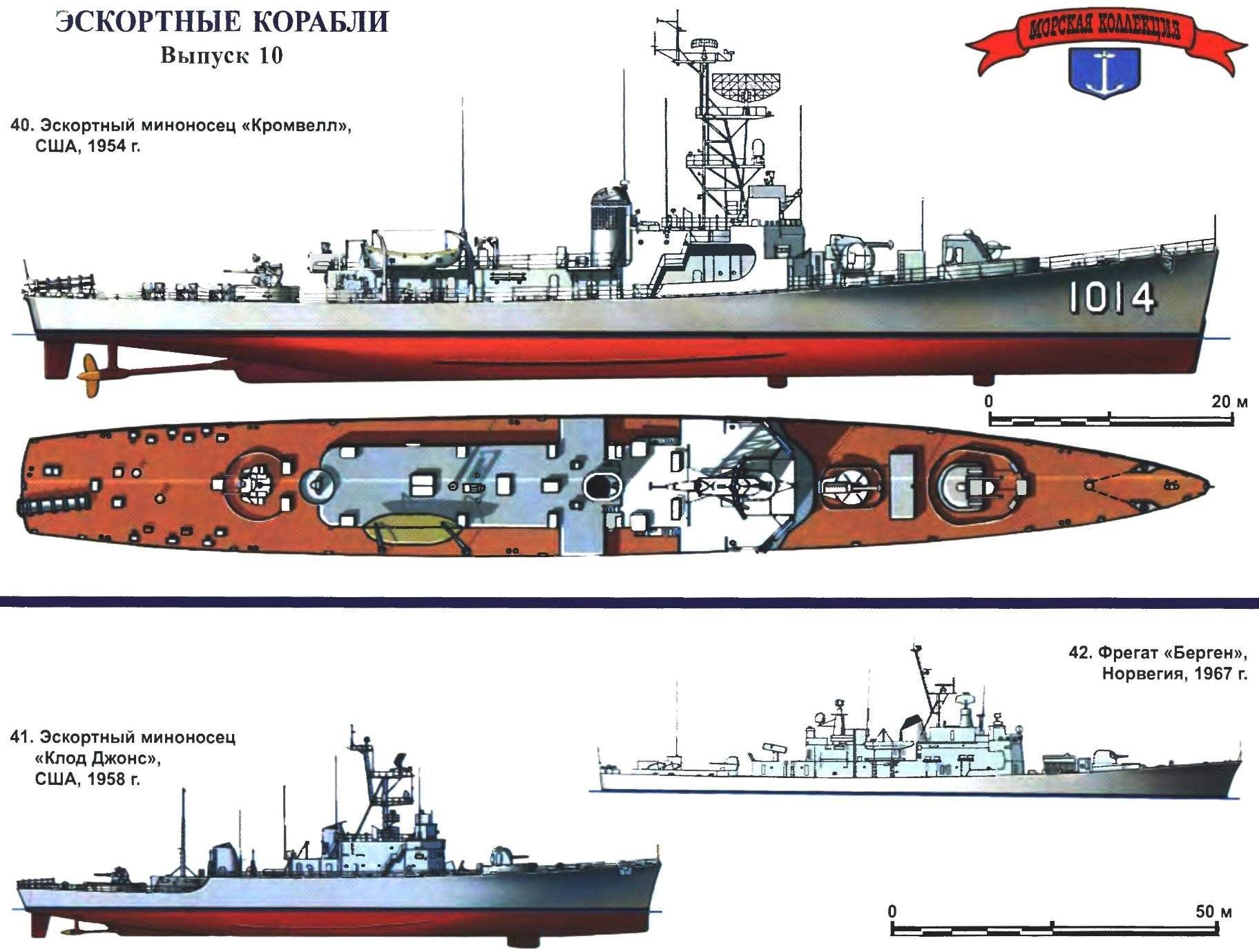 The superiority of the American fleet at sea after the Second world war was so undisputed that the creation of new warships, with the exception of aircraft carriers for the United States look out of date. Even with the advent of the only potential rival — the Soviet Union — high-speed submarines (first new diesel and then nuclear) not only changed the situation. At the disposal of the American admirals had bend pretty new destroyers, which were redirected to the new challenges. One of the most ambitious in the history of fleet upgrades — FRAM (Fleet Rehabilitation And Modernisation programme restoration and modernisation of the fleet) the ships of the PLO became more than 130 destroyers “Fletcher”, “Gearing” and “Allen M. Sumner” (see “modelist-Konstruktor” No. 8 in 2002). Updated the ships it provided the needs of the escort and anti-submarine service in the decade ahead.
The superiority of the American fleet at sea after the Second world war was so undisputed that the creation of new warships, with the exception of aircraft carriers for the United States look out of date. Even with the advent of the only potential rival — the Soviet Union — high-speed submarines (first new diesel and then nuclear) not only changed the situation. At the disposal of the American admirals had bend pretty new destroyers, which were redirected to the new challenges. One of the most ambitious in the history of fleet upgrades — FRAM (Fleet Rehabilitation And Modernisation programme restoration and modernisation of the fleet) the ships of the PLO became more than 130 destroyers “Fletcher”, “Gearing” and “Allen M. Sumner” (see “modelist-Konstruktor” No. 8 in 2002). Updated the ships it provided the needs of the escort and anti-submarine service in the decade ahead.
However, the most reasonable and viable solution had its downsides. Your orders associated with the modernization of the FRAM, was given to companies-developers and manufacturers of weapons and equipment, but out left yourself boat builders: designers and engineers, workers of the shipyards and, more importantly, their owners. The naval component of the American military-industrial complex at that time was a major force, and the shipbuilding lobby managed “dozhat” the government and the leadership of the Navy. The latter was compelled to issue orders for the development and construction of new battle ships of those classes, which, in fact, there was not much need. First and foremost, this was related to anti-submarine and escort ships — their creation in the 1950-ies was due to a desire to provide a mode of support of the industry. The first postwar project of the destroyer escort was developed quite a long time. At first, the “Dili” — the first frigate of this series was assumed in the form of further development of the coastal escortyou PC, but this option did not satisfy the modern requirements either in speed or armament. Had to go on increasing displacement. A “highlight” of the project was the new anti-vehicle — auto-jet sticky bomb launcher MK 108 “Weapon A,” which also received the nickname “alpha” or “Abel”. Externally, mortar, placed in a closed turret, reminiscent of the 127-mm gun mount. Nominal rate of fire was up to 10 bombs per minute, which greatly exceeds the capabilities of the British “Squids” and “limbo” — the acknowledged leaders of this type of weapons in the West.
In practice, however ambitious idea failed. The machine was capricious and often refused (fortunately for the Americans, just for the exercise). But he was the only anti-submarine weapons on Board “ocean escorts” (as officially became known as the type “Dili”). Was weak and artillery, is represented by two 76-mm auto Sparky. No wonder the post-war escort replenishment always been criticized for the lack of armament for their size. Another drawback the new type was the result of the difficulties of wartime, when the mass construction of turbine ships was hampered due to the lack of gears. Scalded milk, Americans now Dooley’s on water. Just in case — and suddenly again, you will need to deploy a large-scale production — “ocean escort” provided a single-shaft power plant, which in the mid-twentieth century seemed an obvious anachronism.
But even such a modest combat capabilities of the ships of the “Dili” was not cheap enough for a hypothetical mass production in case of war, engineers immediately issued an even more simplified “mobilization” project with diesel power. Fortunately for American taxpayers, in a system included only four units of type “Claude Jones”. The famous American Corsair was not lucky: his name was called the ship who was not any decent speed, no powerful weapons, no decent electronics. Weak mortars “Hedgehog”, obsolete at the end of the Second world war, plus a pair of 76-mm guns looked just pathetic. In an attempt to somehow justify the senseless project of “berry” and “Mack Morris” in 1961, equipped with Norwegian RBU “the Turn” and 324-mm torpedo tubes, but still on purpose not used not a single ship of the four. They whiled away the time in the Pacific, formal as courts of radar surveillance (if you have the US many much more suitable and well-equipped ships of this class!). Only in 1973 was the victim who got stuck with the same useless product. All the “Joneses” went to Indonesia, where after the reorientation to the West fleet, which consisted almost entirely of ex-Soviet warships, quickly fell into disrepair and needed urgent upgrading. Escortsite reclassified in frigates, and some even have devouroil old 37-mm and 25-mm automatic guns of Soviet production. Despite its archaic appearance, they are under the Indonesian flag has survived to the twenty-first century.

40. Escort destroyer “Cromwell”, USA, 1954.
Built by “bath Iron Works”. Light displacement, 1315 tons, full 1880 t maximum Length 96 m, width 11,2 m, draft 3.6 m Capacity single-shaft steam turbine 20 000 HP, speed 27 knots. Armament: two twin 76-mm art installation, reactive mortars “alpha”. Total for the project was built in 1954-1958 13: “Dili”, “Cromwell”, “Hammerberg”, “Courtney”, “Leicester”, “Evans”, “Bridget”, “Bauer”, “Hooper”, “Willis”, “van Voorhis”, “Hartley” and “John. Taussig”. In 1972 dilly transferred to Uruguay (renamed the “18 de Julio”), and “Hartley” — the Columbia (renamed “Boyaca”), and the rest excluded from the lists of the fleet in 1973
41. Escort destroyer “Claude Jock”, USA, 1958
Built by “Avondale”. Light displacement, 1315 tons, full 1920 T. maximum Length 95,1 m, width 11,6 m, draught 3,9 m. Capacity single-shaft diesel install 8700 HP, speed 21 knots. Weapons: paired 76-mm gun mount, two reactive mortars “Hedgehog”. Just submitted the project in 1958-1960 built 4 units: “Claude Jones”, “John Perry”, “Charles berry” and “Mack Morris” All transferred to Indonesia in 1973-1974 (renamed “Mungindi”, “Samadikun”, “Member” and “Ngurah Rai”).
42. Regut, “Bergen”, Norway, 1967
Built at the shipyard in Horten. The standard displacement 1450 tons, full 1760 t maximum Length of 96.6 m, a width of 11,2 m, draft 4,7 m. the Capacity of a single-shaft steam-turbine plant of 20,000 HP., speed 26 knots. Armament (after modernization, 1975): six anti-ship missiles “Penguin”, SURA complex “sea Sparrow” (8 launchers), two twin 76-mm artillery systems, 6-barrel rocket mortar “the Turn”, three-pipe, two 324-mm torpedo tubes ASW. In 1966-1967, he only built 5 units: “Oslo”, “Bergen”, “Trondheim”, “Stavanger” and “Narvik”. All upgraded and in 1975-1976 1988— 1991 “Oslo” sank in January 1994 as a result of a navigation accident, the rest are in service or in reserve.
Two small series of ships of the types “Claude Jones” and “Dili” became the only specialized escort units of the US Navy, 1950-ies. In the United States, they are a further development has not received, but has played some role in the postwar Navy European NATO allies. The Americans proposed the project “Dili” as a standard of the European frigate. The first rod fell Norway, attracted by the relative cheapness of the American ship and that the “overseas uncle” agreed to pay half the cost of construction. В1963—1965, at the shipyard in the city of Horten laid five frigates of the “Oslo” differs little from its prototype, except that a somewhat greater height, so necessary in the harsh conditions of the North Atlantic and the Arctic. But as the years passed after the entry of the ships into operation, and the Norwegians embarked on a significant upgrade, completely transformed an inherently weak type. On the decks of frigates appeared anti-ship missiles “Penguin” domestic production and six-barreled rocket mortar “Turn” of the same origin. Both types of weapons were distinguished by small dimensions and a sufficiently high performance characteristics, so one time they were considered as a possible standard for the Alliance. For the purposes of air defense was useful to us small-size antiaircraft complex “sea Sparrow”, created on the basis of one of the best long-range missiles of air combat at that time. In addition, there was a place for a pair of three-pipe torpedo tubes for ASW torpedoes. And guns while stayed! The Americans got an impressive flick on the nose, aggravated by the fact that the northerners at the same time set on their units a whole bunch of electronic equipment from Europe: French, British and Dutch, which was cheaper and better options.
Other allies in the Atlantic Pact, has accepted the American assistance, became Portugal. At the time, one of the poorest countries in Europe, of course, not MoGo to miss neither the means nor the experience to create your own weapons, but even there, chose to replace the proverbial mortar “alpha” for a few four-barrelled 375 mm rocket mortars Swedish “Bofors”. As the Norwegians have also established a few small anti-submarine torpedo tubes. If the North needed improved navigability in the subtropics and tropics could not do without air conditioning systems, superior insulation and powerful refrigerators. From 1966 to 1968 came into operation three units: the “admirals” “Pereira Da Silva”, “Gago Coutinho” and “Magalhaes Correa”.
Surprisingly, there was a country, managed even to learn something from this almost hopeless project, as the “Claude Jones”. It was Turkey, chosen as the prototype of the first ships laid down after 50-year hiatus on private shipyards, the American “mobilization” escortin. However, in his “Burke” and “Pace” Turks managed to significantly enhance the armament compared with the ancestor and even post the helicopter, although in an open area without the hangar. Increased speed due to the replacement of the us diesels are more powerful motors of the Italian company “Fiat”, the exhaust from which was given in one impressive pipe.
It would seem, the example of the allies should make the Americans a little bit to improve their own ships. However, it seems that the leadership of the US Navy, just waved his hand at his first post-war escort ships, holding them only a minimum of work. After the failure of mortars “And Upon” with “Dili” was removed this cumbersome installation, replacing it with a compact 324-mm torpedo tubes three-pipe PLO, which became the standard armament of almost all the warships of the United States. On three frigates (“Dili” and its sistership “Courtney” and “Cromwell”) removed the aft 76 mm spark to replace it with another dead-end kind of weapon — a radio-controlled helicopter system “DASH”. Final desperation is setting to cut the stern of a single 40 mm “Bofors” army model, made by command of the Pacific fleet during the Vietnam war.
So ignominiously ended in the establishment of the first post-war escort ships, unnecessary and unsuccessful. And the lifetime of the updated program destroyers FRAM is gradually came to an end, and they needed a replacement. So after a few years the Americans had to forget about the dubious designs of the 1950s and start it from scratch. But this will be discussed later.
V. KOFMAN
Recommend to read
 MICROMEMORY
MICROMEMORY
Sketch small motomobile truck, about which speech will go, I found in an old folder during the big tidy-bulkhead in garage archive. They are inspired by memories of the days when the... INDICATOR ACCURATE SETTINGS
INDICATOR ACCURATE SETTINGS
To radio sounded good on the UHF band, it should be adjusted to exactly take the radio. Will help you with this indicator fine adjustment circuit of which offers Bulgarian journal "Radio...
 The superiority of the American fleet at sea after the Second world war was so undisputed that the creation of new warships, with the exception of aircraft carriers for the United States look out of date. Even with the advent of the only potential rival — the Soviet Union — high-speed submarines (first new diesel and then nuclear) not only changed the situation. At the disposal of the American admirals had bend pretty new destroyers, which were redirected to the new challenges. One of the most ambitious in the history of fleet upgrades — FRAM (Fleet Rehabilitation And Modernisation programme restoration and modernisation of the fleet) the ships of the PLO became more than 130 destroyers “Fletcher”, “Gearing” and “Allen M. Sumner” (see “modelist-Konstruktor” No. 8 in 2002). Updated the ships it provided the needs of the escort and anti-submarine service in the decade ahead.
The superiority of the American fleet at sea after the Second world war was so undisputed that the creation of new warships, with the exception of aircraft carriers for the United States look out of date. Even with the advent of the only potential rival — the Soviet Union — high-speed submarines (first new diesel and then nuclear) not only changed the situation. At the disposal of the American admirals had bend pretty new destroyers, which were redirected to the new challenges. One of the most ambitious in the history of fleet upgrades — FRAM (Fleet Rehabilitation And Modernisation programme restoration and modernisation of the fleet) the ships of the PLO became more than 130 destroyers “Fletcher”, “Gearing” and “Allen M. Sumner” (see “modelist-Konstruktor” No. 8 in 2002). Updated the ships it provided the needs of the escort and anti-submarine service in the decade ahead.



